Part I: This is the first of a two-part series about how we can use food as medicine. In the first segment below, I discuss different whole foods and herbs that show well-documented medicinal properties. In August 2017, I will focus on how some plant and herb compounds serve as precursors for drugs to treat specific health conditions.
Food-Based Medicine
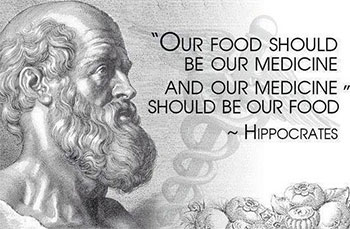 It was Hippocrates in 400 B.C. who advised people to prevent and treat disease first and foremost by eating nutrient-dense foods. The quote: “Let medicine be thy food and let food be thy medicine,” attributed to the ancient Greek physician, stands as one of the earliest affirmations that foods hold healing properties.
It was Hippocrates in 400 B.C. who advised people to prevent and treat disease first and foremost by eating nutrient-dense foods. The quote: “Let medicine be thy food and let food be thy medicine,” attributed to the ancient Greek physician, stands as one of the earliest affirmations that foods hold healing properties.
In addition to historical and folk evidence, including Ayurveda (whole-body healing systems) and traditional Chinese medicine, Western-based medicine investigates healing properties of food and food derivatives (mostly from plants).
Phytotherapy
The evidence base for Western herbal and food medicine, known as phytotherapy, involves the use of plant-containing phytochemicals (chemical compounds in plants) in the treatment and prevention of disease. But it lags behind other nutritional sciences. This is because phytochemicals are ingested as complex mixtures that are incompletely characterized. Only recently have scientists begun to scrutinize their properties.
The concept and use of the term phytotherapy originated with French physician Henri Leclerc (1870-1955). He introduced it in 1913 and incorporated it into his text, Précis de Phytothérapie (Handbook of Phytotherapy), first published in 1922. The term phytotherapy entered the English language with its common definition in 1934; Eric Frederick William Powell (1895-1991), an English practitioner of herbalism and homeopathy, is credited with its introduction.
Phytochemicals
Major phytochemicals include carotenoids and polyphenols, which include phenolic acids, flavonoids, and stilbenes/lignans. We can further divide flavonoids into groups based on their similar chemical structure, such as anthocyanins, flavones, flavanones, isoflavones, and flavanols. Flavanols further are classified as catechins, epicatechins, and proanthocyanidins.
Obviously, the science of phytotherapy and phytochemicals is complicated, to say the least!
Randomized clinical trials of single-herb/food interventions are relatively easy to undertake, and journals are publishing more and more studies all the time. But phytotherapy represents a holistic approach aimed at reinstating body homeostasis, and is thus more difficult to submit for comprehensive research.
Early research on phytotherapy
 In 1950, an early study jumpstarted investigation into phytotherapy, examining effects of diet on the body’s response to X-ray exposure, which was beginning to gain diagnostic popularity. In this experiment, guinea pigs exposed to whole-body X-ray had lower mortality and incidence of hemorrhage when pre-fed cabbage, than when pre-fed beets. Rather than conclude that ingredients in cabbage were protective against radiation, the researchers deduced that something in beets became highly toxic when exposed to X-ray. The idea that a property in food (in this case cabbage) could offer significant protection against radiation was just too “far out” to be taken seriously at that time.
In 1950, an early study jumpstarted investigation into phytotherapy, examining effects of diet on the body’s response to X-ray exposure, which was beginning to gain diagnostic popularity. In this experiment, guinea pigs exposed to whole-body X-ray had lower mortality and incidence of hemorrhage when pre-fed cabbage, than when pre-fed beets. Rather than conclude that ingredients in cabbage were protective against radiation, the researchers deduced that something in beets became highly toxic when exposed to X-ray. The idea that a property in food (in this case cabbage) could offer significant protection against radiation was just too “far out” to be taken seriously at that time.
Different researchers executed a follow-up experiment nearly 10 years later. They exposed guinea pigs to whole-body X-ray after two weeks on varying diets. Animals fed oats and bran died within 15 days of X-ray exposure. In contrast, animals fed oats and bran, but supplemented with raw cabbage, had an average reduced mortality of 52 percent. In two additional experiments, the scientists discovered broccoli, a relative of cabbage, proved to be even more protective against X-ray damage. In still more experiments, both pre- and post-X-ray feeding of cabbage was found to exert statistically significant protective effects against X-ray damage.
Now, almost 50 years later, scientists are focusing increased attention and activity on how food can be used to prevent and treat acute and chronic diseases.
How foods can work like medicines
Here are five ways medicinal foods act like natural protectors against disease development.
- Decrease and control inflammation – Inflammation represents a major root cause of many chronic diseases. Inflammatory processes can affect nearly every tissue, hormone, and cell in the body.
- Balance hormones – Hormones affect biologic functions, including energy storage and production, cognitive abilities, body weight, and sex drive. Negative hormonal changes and imbalances contribute to accelerated aging, diabetes, obesity, fatigue, depression, low mental capacity, reproductive problems, and an array of autoimmune diseases.
- Alkalize the body – The body attempts to maintain a consistent internal pH of around 7.36, a slightly alkaline level. (The pH scale ranges from 0-14; values higher than 7 are alkalizing; values less than 7 are acidic.) The kidneys achieve alkaline balance by filtering out excessive acids and excreting them in urine. Gradual acidic overload can lead to increased incidence of kidney stones, chronic kidney disease, muscle degradation, reduced bone density, and even arthritis, diabetes, and cancer. Processed foods and animal-based foods contribute to overall acidic levels, and plant-based foods contribute to overall alkaline levels. Here are examples of high, moderate, and low alkaline plant-based foods.
- Balance blood sugar – Poorly managed blood-sugar levels can lead to a host of biologic complications, including neurological damage, mood disorders, hormonal imbalances, kidney disease or kidney failure, strokes, heart attacks, vision loss or blindness, and a weakened immune system, with a greater risk of infections and erectile dysfunction.
- Improve nutrient absorption (bioavailability) – Diet-related factors in plant foods that affect bioavailability include the chemical form of the nutrient in food and/or nature of the food matrix; interactions between nutrients and other organic components like phytates, polyphenols, dietary fiber, oxalic acid, protein, fat, and ascorbic acid; and the extent of processing and/or preparation practices.
Medicinal foods
Here are examples of well-researched plant-based foods demonstrating verified medicinal properties. In my discussion, I divide these foods into color groups for ease of understanding. I also list some of their more potent compounds.
Red Group
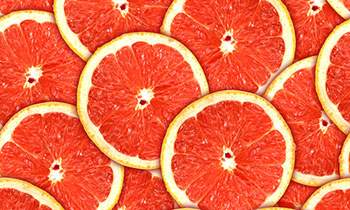 Tomatoes, pink grapefruit, watermelon
Tomatoes, pink grapefruit, watermelon
These foods contain the carotenoid lycopene, which helps decrease free radical levels. Lycopene helps protect against prostate cancer and heart and lung disease. One glass of tomato juice supplies 50 percent of recommended lycopene intake.
Yellow/Green Group
Spinach greens, collard greens, mustard greens, turnip greens, yellow corn, green peas, avocado, honeydew melon
These food sources are high in the carotenoids lutein and zeaxanthin, which reduce the risk of cataracts and age-related macular degeneration. Lutein, a yellow-green substance, concentrates in the rear of the eye. It also has been reported to reduce atherosclerosis risk.
Orange Group
Carrots, mangos, apricots, cantaloupes, pumpkin, acorn squash, winter squash, sweet potatoes
These foods contain alpha carotene, which protects against cancer. They also contain beta-carotene, which converts to vitamin A in the body to protect the skin against free-radical damage and helps repair damaged DNA. Beta-carotene also is good for night vision. It’s important to note that these beneficial nutrients can be received from other foods, too, i.e., vitamins in dairy products and meat.
Orange/Yellow Group
Pineapples, oranges, tangerines, peaches, papayas, nectarines
These foods contain beta cryptothanxin, which helps cells communicate, and also may help prevent heart disease. In addition, a single orange contains 170 percent of the recommended daily vitamin C. It’s interesting to note that the skin of an orange is high in a protective fat that has been found to kill some cancer cells in humans and animals.
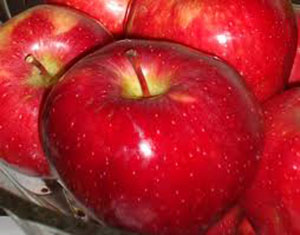 Red/Purple Group
Red/Purple Group
Beets, eggplant, purple grapes, red wine, grape juice, prunes, cranberries, blueberries, blackberries, strawberries, red apples
These foods contain powerful antioxidants called anthocyanins believed to protect against heart disease by preventing blood clots. They also may delay cell aging. Some evidence exists that indicates they may help delay the onset of Alzheimer’s disease.
White/Green Group
Leeks, scallions, garlic, onions, celery, pears, white wine, endive, chives
The onion family contains allicin, which has anti-tumor properties. Other foods in this group contain antioxidant flavonoids like quercetin and kaempferol, a natural flavonol.
Green Group
Broccoli, brussels sprouts, cabbage, Chinese cabbage or bok choy, kale
These foods contain the chemicals sulforaphane and isocyanate, and they also contain indoles, all of which have been reported to affect cancer cell growth.
Medicinal herbs for healing
Below are just four of many examples of herbs — backed by research — that warrant their use for medicinal purposes.
Ginger
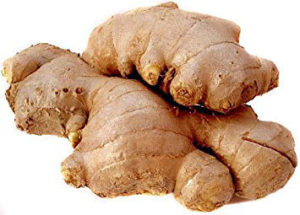 Zingiber officinale is a flowering plant widely used as a cooking spice. But it also has a long history of successful medicinal use. In traditional Chinese and Indian medicine, healers used ginger to treat ailments including stomach aches, diarrhea, nausea, asthma, respiratory disorders, toothache, gingivitis, and arthritis.
Zingiber officinale is a flowering plant widely used as a cooking spice. But it also has a long history of successful medicinal use. In traditional Chinese and Indian medicine, healers used ginger to treat ailments including stomach aches, diarrhea, nausea, asthma, respiratory disorders, toothache, gingivitis, and arthritis.
Ginger and its extracts are recommended primarily for dyspepsia (impaired digestion of different causes), and prevention of motion sickness. A considerable body of scientific data supports the long-held view that ginger offers a broad spectrum of anti-inflammatory benefits. We know ginger contains compounds that inhibit prostaglandins synthesis, thought to be the cause of pain, similar in effect to non-steroidal anti-inflammatory drugs (NSAIDs), the most used over-the-counter medicine for pain. In moderate doses, ginger has been shown to have few side effects.
Garlic
Garlic is a bulbous plant about 3-4 feet in height. Allicin represents the principal bioactive compound in the liquid extract of garlic or raw garlic. But garlic also includes other important compounds with medicinal properties: organosulfur compounds, quercetin, flavonoids, and saponins. Both experimental and clinical studies on different garlic preparations demonstrate favorable cardiovascular effects, anti-tumor and anti-microbial effects, and reduction of some toxic agents.
Lavender oil
 The flowers and leaves of the lavender plant (lavandula angustifolia) are used as an herbal medicine, either in the form of lavender oil or as an herbal tea. Lavender oil has a chemically complex structure with more than 150 active chemicals. Silexan is a prepared lavender oil extract in capsule form. It has been used successfully in clinical trials to treat such generalized anxiety disorder symptoms as impaired sleep, somatic complaints, comorbid depression, and decreased quality of life.
The flowers and leaves of the lavender plant (lavandula angustifolia) are used as an herbal medicine, either in the form of lavender oil or as an herbal tea. Lavender oil has a chemically complex structure with more than 150 active chemicals. Silexan is a prepared lavender oil extract in capsule form. It has been used successfully in clinical trials to treat such generalized anxiety disorder symptoms as impaired sleep, somatic complaints, comorbid depression, and decreased quality of life.
In one study, researchers studied effects of Silexan in patients with anxiety-related restlessness and disturbed sleep. One hundred seventy outpatients with diagnosed restlessness, anxiety, and insomnia participated in a randomized, double-blind study. They took 80mg Silexan or placebo once daily for 10 weeks. The study confirmed the statistically beneficial effects of the lavender oil compared to the placebo for all variables.
Turmeric
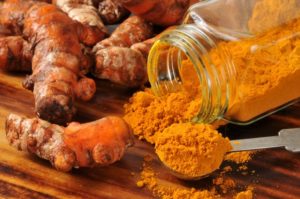 Turmeric is a rhizomatous herbaceous perennial plant (Curcuma longa) of the ginger family that reaches up to 3 feet tall. It is highly branched, yellow/orange in color, and cylindrical in shape. Major medicinal properties are based on turmeric’s curcuminoids, the most important of which is curcumin, usually taken as an extract in combination with black pepper to increase bioavailability.
Turmeric is a rhizomatous herbaceous perennial plant (Curcuma longa) of the ginger family that reaches up to 3 feet tall. It is highly branched, yellow/orange in color, and cylindrical in shape. Major medicinal properties are based on turmeric’s curcuminoids, the most important of which is curcumin, usually taken as an extract in combination with black pepper to increase bioavailability.
Sufficient research evidence supports turmeric (curcumin) as an anti-inflammatory agent. It demonstrates strong antioxidant capacity and assists in boosting a brain-derived neurotropic factor linked to improved brain function. It has been shown to be effective in lowering the risk of developing heart disease, treating some cancers, helping symptoms of arthritis, and alleviating symptoms of depression.
So, I suggest we all try to consume more plants and herbs. It’s good medicine!
References
- Aghajanpour, M. et al. 2017. “Functional foods and their role in cancer prevention and health promotion: A comprehensive review.” American Journal of Cancer Research; 7(4):740.
- Bronowski, J. 1973. “The ascent of man.” British Broadcasting Corporation, London, England; Little, Brown and Company, Boston/Toronto.
- Daily, J. et al. 2016. “Efficacy of turmeric extracts and curcumin for alleviating the symptoms of joint arthritis: A systematic review and meta-analysis of randomized clinical trials.” The Journal of Medicinal Food; 19:717. doi:10.1089/jmf.2016.3705.
- Eaton, B.S. 2006. “The ancestral human diet: What was it and should it be a paradigm for contemporary nutrition?” The Proceedings of the Nutrition Society; 65:1.
- Gibson, R. et al. 2006. “Improving the bioavailability of nutrients in plant foods at the household level.” The Proceedings of the Nutrition Society; 65:168.
- Hasler, C. 1996. “Functional foods: the Western perspective.” Nutrition Reviews; 54(11),S6-S10.
- Holbrook, A.M., et al. 2005. “Systematic overview of warfarin and its drug and food interactions.” Archives of Internal Medicine; 165:1095-1106.
- Kasper, S. 2017. “Silexan in anxiety disorders: Clinical data and pharmacological background.” World Journal of Biological Psychiatry; 17:1-25.
- Kasper, S. et al. 2015. “Efficacy of orally administered Silexan in patients with anxiety-related restlessness and disturbed sleep — A randomized, placebo-controlled trial.” European Neuropsychopharmacology; 25(11):1960doi.
- Kligler, B. 2016. “Complementary/integrative therapies that work: A review of the evidence.” American Family Physician; 94(5):369.
- Leyla, B. et al. 2014 “Garlic: A review of potential therapeutic effects.” Avicenna Journal of Phytomedicine; 4(1): 1–14.
- Lourau, M. et al. 1950. “Influence of the diet on the biological effects produced by a unique whole body irradiation (X rays)].” Experientia; 6(1):25.
- Reinhard, G. et al. 2005. “Ginger: An herbal medicinal product with broad anti-inflammatory actions.” Journal of Medicinal Food; 8(2),125–132.
- Spector, H. et al. 1959. “Reduction of Xradiation mortality by cabbage and broccoli.” Proceedings of the Society for Experimental Biology and Medicine; 100:405.
- Taylor, L. 2005. “The healing power of rainforest herbs.” Square One Publishers, Garden City Park, N.Y. 11040. ISBN: 0-7570-0144-0
- Zeng, Y. et al. 2017. “Therapeutic role of functional components in alliums for preventive chronic disease in human being.” Evidence-Based Complementary and Alternative Medicine; 9402849. doi: 10.1155/2017/9402849.




Randall Finn - 1974
In the “Orange/Yellow Group” you say, “It’s interesting to note that the skin of an orange is high in a protective fat that has been found to kill some cancer cells in humans and animals”. I quit eating the rind of of citrus fruits years ago when I read the following in the “Food and Nutrition Encyclopedia”: The articles on grapefruits and oranges said “Citrus peel contains citral, an aldehyde that antagonizes the effects of vitamin A. Hence, people should make certain that their vitamin A intake is adequate before consuming large amount of grapefruit peel (or orange peel)”.
The article on citral said “Citral is a constituent of orange peel that is suspected of causing damage to blood vessels when large amounts are consumed”.
Reply
Adam Rubinstein - 1985
The only “food” which has consistently proved protective is abstention, calorie restriction, and/or periodic fasting. The fallacy of marketing the protective benefits of all of these food groups is that folks still tend to over eat. Of the herbs highlighted, perhaps one of the most thoroughly studied and compelling is that of Tumeric. Not only does it exert significant effect upon reducing inflammation as evidenced by decreased expression of tumor and other inflammatory markers, have favorable benefits on lipid oxidation, but has favorable effects on glucose metabolism as well (read diabetes).
From a larger perspective many pharmaceuticals were and are derived from plant/animal sources so the concept of biologically active compounds emanating from these sources should not be foreign. The problem is that obtaining sufficient and stable quantities from food can be problematic.
Reply